You don’t have to be in a Hollywood spy movie to want to see in the dark. If you do anything at night, whether it’s hunting, trail driving, or you just show up late to your campsite, a simple night vision device is a great tool to have.
The good news is that now is a better time than ever to buy one. We have come a long way from the days of stale green, heavy, and expensive devices. If you are in the market for a night vision device, a compact and ultra-versatile monocular is a great option.
We put together this guide so you can grab an excellent monocular that will fit right into your lifestyle, whether that’s prepping for the apocalypse or a bit of airsoft on the weekend. We’ll start with a quick breakdown of what you need to know to differentiate models and then launch into a top ten list to narrow down your options. After that, we’ll get into some of the more complicated concepts so you can learn everything there is to know about this technology.
- Buying the Right Night Vision Monocular
- Top 10 Best Night Vision Monoculars 2025
- 1. Best Overall Monocular: SiOnyx Aurora Sport
- 2. Best Budget Monocular: Firefield Nightfall
- 3. Best Hunting Monocular: Leupold LTO Tracker 2 HD
- 4. Best Premium Monocular: Pulsar Axion XM30
- 5. Monocular With the Best Image Quality: Night Owl iGEN
- 6. Easiest Monocular to Use: Bushnell Equinox Z
- 7. Best Monocular for Recording Video: SiOnyx Aurora
- 8. Best Compact Monocular: FLIR Scout TK
- 9. Best Pocket Night Vision Monocular: Carson MiniAura
- 10. Best Monocular Alternative: WP7 Rugged Smartphone
- In-Depth Guide to Night Vision Monoculars
- Enjoy the Dark
Buying the Right Night Vision Monocular
Night vision is a simple concept. Even in the dead of night, there is still a small amount of light. If you magnify that light enough, you can see in the dark. Scientists figured out how to do that in the early 1900s. In fact, the US has been outfitting soldiers with night vision capabilities as far back as WWII, and they have been improving things ever since.
This has led to a ton of different features and options over the years as companies have improved on those designs. When you choose one for yourself, you’ll need to at least have some idea of which of those features you want. In the following section, we’ll try to touch on many of the common features so you’ll have an idea of what to look for.
Major Considerations
There are three main things to compare when looking at night vision devices, and those will probably be your biggest considerations when deciding on one for yourself.
Image Quality
First and foremost, when you buy a night vision monocular, you want to be able to see in the dark. How far and how well you can see in the dark can vary greatly. We’ll discuss some of the different technologies in the big guide below, but there are basically two main types of night vision devices: Digital and Generational.
Digital devices have largely replaced the classic generations of night vision. They offer better image quality, although the lower end of the market still contains some very good budget generational devices. Digital devices can also do a lot more than a traditional device, like take pictures or transmit the image to other technology.
The spectrum and amount of light they can capture will directly influence how much you can see. We have included videos from around the web that show what each monocular looks like when you look through it so you can see for yourself.
Common Features
There are a handful of common features that you may want from a monocular. Look for things like:
- The ability to record video
- The ability to take pictures
- The inclusion of an IR illuminator, a device that is like a night vision flashlight
- Different color modes
- Magnification
- Rechargeable batteries
- Mounts for helmets or rifles
What You Want to Do With Night Vision
The best way to make sense of these considerations is to determine what you want to do with the device. Here are some suggestions:
- Documenting Adventures: If you want to record videos to share, consider looking for monoculars that make it easy to record and post. You’ll probably need to spend more so that the video quality translates well to bigger screens.
- Hunting: There are a lot of monoculars that have special features that make tracking things easier. If you are hunting boars or ghosts, thermal imaging will probably be at the top of your want list, and you’ll probably want to look for something with 4x magnification or greater. To spot something miles away, you’ll probably want a dedicated pair of hunting binoculars, too.
- Off-Roading: Out on the trails at night, you’ll need a way to spot obstacles or scout ahead. A monocular that is easy to use and can be stored in your vehicle will probably suit you best.
- Home Security: Being able to survey your land and tell at a glance whether the sound you hear is a burglar or a raccoon can help you sleep soundly. Clear visuals, illuminators, and the ability to snap a picture will help you quickly identify would-be trespassers and document them.
With all that in mind, let’s get into the reviews.
| Product | Type | Magnification | Illuminator | Rating |
|---|---|---|---|---|
| SiOnyx Aurora Sport | Digital | 1x | Not Included | 5 |
| Firefield Nightfall | Gen 1 | 4x | Included | 5 |
| Leupold LTO Tracker 2 HD | Digital | 1x | Not Included | 4.5 |
| Pulsar Axion XM30 | Digital | 4-16x | Not Included | 4.5 |
| Night Owl iGEN | iGEN (digital) | 2.6x | Included | 4 |
| Bushnell Equinox Z | Digital | 4.5x | Included | 4 |
| SiOnyx Aurora | Digital | 1x | Not Included | 4 |
| FLIR Scout TK | Digital | 1x | Not Included | 4 |
| Carson MiniAura | Digital | 1x | Included | 3.5 |
| WP7 Rugged Smartphone | Digital | 1x | Included | 3.5 |
Top 10 Best Night Vision Monoculars 2025
1. Best Overall Monocular: SiOnyx Aurora Sport

Editor’s Rating:
Facts at a Glance
- Type: Digital
- Magnification: 1x
- Illuminator: Not Included
- Demo Video
What’s It Best For?
The Aurora Sport does two things that make it a perfect all-around tool. First, it doubles as a fully functional action camera. If you are hunting ghosts or bigfoots in the dead of night, you’ll be sure to capture whatever you see. Second, it’s one of the few offerings that displays an image with something close to accurate color. It’s not perfect, but it doesn’t take any getting used to.
With those two features, you get a device that almost anyone can find utility in. Want a night vision dash cam for recording your night crawling through the Rubicon? It can do it. Want to send your buddy out into the freezing night to spot for you as you crawl on some rocks? It’s a great tool for that too.
How Does It Compare?
The big problem with the Sport is that by being an all-arounder, it doesn’t do anything particularly well.
It’s not the best night vision imaging on our list for the price; that honor would go to something like the Night Owl. Any of the conventional generation 1 devices are cheaper, and many devices are a lot more portable and better suited for hunting. Honestly, if you are doing a lot of hunting, get the Leupold LTO. Even if you opt for the cheaper options, you’ll still be super happy with it because of the high contrast images and longer range.
That all being said, though, nothing except its more expensive sibling comes close in terms of all-around functionality. The more expensive Aurora has a few features that the less expensive Aurora Sport doesn’t have, like GPS and extra shock absorption for mounting to firearms. They both have a great battery, although it is brand-specific, and they both function in an extremely intuitive way.
In the end, though, the Sport does 99% of everything you could want, and we can honestly say that if you just want something to help you see in the dark, you won’t be disappointed.
Pros
- Can record, take photos, and act as a simple scope
- Is very intuitive to use
- You don’t have to get used to how traditional night vision looks
Cons
- The image is lower quality compared to a dedicated scope
- Uses a proprietary battery
2. Best Budget Monocular: Firefield Nightfall

Editor’s Rating:
Facts at a Glance
- Type: Gen 1
- Magnification: 4x
- Illuminator: Included
- Demo Video
What’s It Best For?
The Firefield Nightfall is the absolute perfect tool for anyone that wants to scope things out in the dark but doesn’t have much money to spend. It is a simple, rugged device that has an integrated illuminator; it’s all you need if you are just trying to find your tent in the dark or spot wildlife on a night hike.
How Does It Compare?
This scope punches way above its budget in terms of functionality, and that’s why we like it so much. It has an illuminator, which sets it apart from many budget options, and it’s surprisingly well built.
It also has 4x magnification, which really sets it apart from our other budget option, the Carson MiniAura. The MiniAura is a lot more compact, so if portability is your main concern, it’s a better bet. The Firefield really does do everything else better, though, so unless you really need a pocket-sized night vision monocular, get the Firefield.
The drawback is that everything else will give you a better view except for the previously mentioned Carson. It’s a traditional generation 1 device that just will never have the contrast or range of a digital or higher generation device. The Night Owl iGen probably has the best image you can get for the price. Those cost more, but they have a digital processor that refines the image.
For general purpose stuff, though, the Firefield is a fine addition to any kit, especially for the price. Just take a look at the example; you’ll probably be as impressed as we were.
Pros
- Inexpensive
- Durable
- Has 4x magnification and an illuminator
Cons
- The image quality and range isn’t great
- It’s on the large side
3. Best Hunting Monocular: Leupold LTO Tracker 2 HD
![]()
Editor’s Rating:
Facts at a Glance
- Type: Digital
- Magnification: 1x
- Illuminator: Not Included
- Demo Video
What’s It Best For?
The Tracker 2 sacrifices almost all the features you’d find on other monoculars in order to be the ultimate game spotting tool. It doesn’t record, it doesn’t take pictures, and it doesn’t have digital zoom. It has no illuminator, and it won’t help you navigate.
What it will do is survive with you on a three-day trek through the wilderness as you chase down an animal. It’s specially designed to have absolutely bulletproof durability, and it has insanely high-contrast imaging that highlights warmth. You can spot a buck at 700 yards in the dead of night, even if it’s mostly obscured by branches.
It’s good for more than just game, though; you can hit the button and highlight absolutely anything with a heat signature. If you are playing follow the leader running night drives through the desert, your copilot can easily keep track of the convoy using their exhaust trail.
How Does It Compare?
The Tracker 2 is unparalleled when it comes to spotting heat sources and withstanding harsh elements. If you want anything else from a monocular, though, there are better options. The Pulsar Axion is a very good spotting scope and can do things like snap pictures and record video. It’s more expensive than the Tracker 2 HD, but not much.
If the price is an issue, the FLIR TK Scout is compact, easy to use, and highly sensitive to thermal signatures. It’s very similar in function and idea to the Tracker, it’s just not as robust or good at highlighting signatures. If the Tracker 2 HD is out of your budget and you need to take pictures, get the FLIR TK Scout. Otherwise, just get the less expensive non-HD LTO Tracker here.
Pros
- Beautiful high-contrast image
- Very compact
- Waterproof and durable
Cons
- On the expensive side
- Has very few extra features
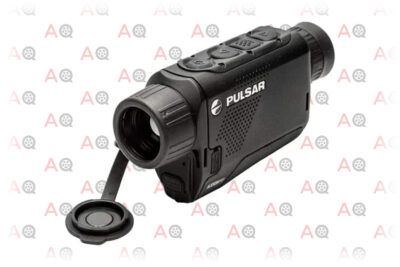
Editor’s Rating:
Facts at a Glance
- Type: Digital
- Magnification: 4-16x
- Illuminator: Not Included
- Demo Video
What’s It Best For?
The XM30 feels like it’s straight out of a spy film. You can dial in some amazing high-contrast video feeds, take pictures, and there are enough settings and display types to make you feel like the thing was a present from Bond himself.
What that translates to is that this is a pretty serious tool with a high cost to match. It’s one of the highest quality monoculars you can buy. People who want the highest quality they can get will not be disappointed.
How Does It Compare?
First things first, nothing on our list is as expensive as this monocular. That can be a tough obstacle to overcome, especially when the Leupold LTO is also a very competent, high-definition monocular, and it’s quite a bit cheaper. Your hunting buddies won’t be lining up to look through the Leupold, though.
It also is a little harder to use than other devices. It takes video, but it’s not as easy to use. In fact, the whole form factor leaves a little bit to be desired. You will need to change the settings around to fit your style, but the buttons are not easily accessible.
These are really nitpicky points, though. That’s because there’s not much to complain about. It’s not a great video camera, fine. If you want a video camera, grab the Aurora Pro. If you want a really competent hunting and spotting tool, the XM30 is absolutely fantastic.
Pros
- Amazing image quality
- Has a lot of settings for dialing in your preferences
- Has recording and image capture capabilities
Cons
- It’s pretty expensive
- It may take you a while to get used to how to use it
5. Monocular With the Best Image Quality: Night Owl iGEN

Editor’s Rating:
Facts at a Glance
- Type: iGEN (digital)
- Magnification: 2.6x
- Illuminator: Included
- Demo Video
What’s It Best For?
If you want to really experience what modern night vision is like, give this monocular a try. First, it displays a really fantastic image without being super expensive. Second, it’s not the bright green display you are probably expecting. Instead, you can choose between black and white, green, red, and amber. Many people prefer black and white to the standard green. It’s not better per se; it’s just that many people find it easier to get used to a black and white image.
How Does It Compare?
When it comes to what you can see with it, it really stands out. You’d have to spend a lot more on something like the Pulsar Axion to get better quality. Even then, unless you are really taking advantage of the fine-tuning that the Axion brings, you might even prefer the Night Owl.
There are a few issues that can be a deal-breaker with the Night Owl, though. The first thing is that if you care about recording video, leave the Night Owl behind. It has a video output that you can theoretically hook up to something, but unless you plan on lugging around an old laptop with you wherever you go, you probably don’t have a way to record that output.
It also just sucks through batteries. Unless you carry piles of double As with you, you’ll have to ration your spotting power.
It’s hard to argue with the quality, though. If you aren’t worried about being found, you’ll be fine.
Pros
- It’s a great value
- You get a choice of screen colors
- Very good image quality
Cons
- The recording feature is difficult to utilize
- It’s not great for longer expeditions
6. Easiest Monocular to Use: Bushnell Equinox Z
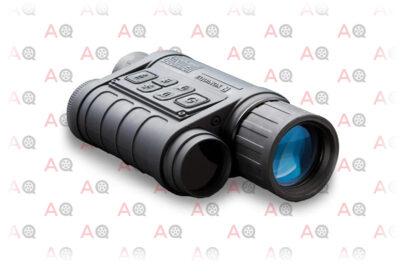
Editor’s Rating:
Facts at a Glance
- Type: Digital
- Magnification: 4.5x
- Illuminator: Included
- Demo Video
What’s It Best For?
The Bushnell Equinox Z is a perfect general purpose spotter. The 750ft viewing range is perfect for looking for things in the distance, and the IR illuminator brings out the detail in things that are up close. Add in the water-resistant, durable housing, and you have a great backpacking or off-roading spotting scope that you can rely on.
How Does It Compare?
This monocular sits comfortably between the Night Owl and the Firefield. It’s less expensive than the Night Owl but lacks the sharpness. It’s more expensive than the Firefield, and it has a better quality to match the price increase.
What sets the Bushnell apart is that it is a digital monocular that is really easy to use. You get many perks of a digital device, like the ability to snap pictures, without the added complexity of other units like the Night Owl. That simplicity also allows the Bushnell to be really robust and water-resistant, so you can drop it a few times and it won’t have any issues.
One final thing to note is that Bushnell is a well-known brand in the hunting and optics world. That’s probably not a significant deciding factor on its own, but if you already have an 8×50 scope and a pair of binocs from Bushnell, you can add in this night vision device to round out your kit.
Pros
- Bushnell is a trusted brand
- It’s very easy to use
- It’s extra durable
Cons
- The image quality is just ok
- It costs more than similar products because of the brand name
7. Best Monocular for Recording Video: SiOnyx Aurora
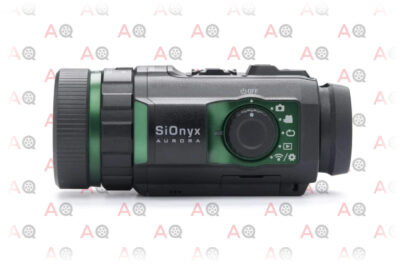
Editor’s Rating:
Facts at a Glance
- Type: Digital
- Magnification: 1x
- Illuminator: Not Included
- Demo Video
What’s It Best For?
It’s everything that the Aurora Sport is, just beefed up. One of the biggest differences is that it’s specially outfitted to survive being attached to a rifle, so you can use it for hunting and airsoft. If you ever wanted to record a night game and post it to youtube, this is a really fantastic tool for that.
It goes beyond that, though. Everything about this monocular lends itself to outdoor sports. It takes a picture when it senses recoil, it has an onboard GPS, and it can constantly display a compass in the viewfinder. It’s set up from the factory to be your tactical night operation companion.
How Does It Compare?
There are a few things you have to really think about before buying this Aurora monocular. The first is whether or not you will take advantage of the weapon rating. It’s very easy to mount the Aurora inline with an optic on a rail, which is great if that’s something you want to do.
If, however, you just want a spotting scope or a simple viewfinder for tracking, there are much better options. The FLIR TK is cheaper and has a much higher contrast for spotting animals.
The second thing to think about is the cost compared to the Aurora Sport. The truth is that the Aurora Sport is still a highly capable device. In the demo link above, you can see that the image quality between the Pro and the Sport is very similar. If you don’t need WiFi or the ability to mount it to a rifle, you’d be saving a lot of money by just picking up the Sport instead.
That being said, you won’t find an easier to use night vision action camera, and you especially won’t find one that easily mounts to a sight rail. Those features make the Aurora an excellent device for anyone that wants to record their escapades.
Pros
- Easy to use
- Has features that make it good for mounting to firearms
- Super durable
Cons
- Image quality isn’t amazing
- It’s a little expensive compared to competitors
8. Best Compact Monocular: FLIR Scout TK
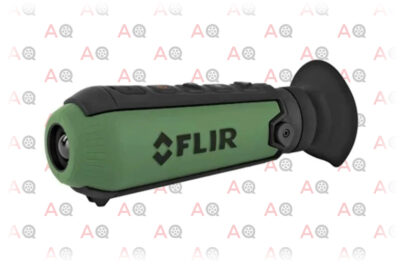
Editor’s Rating:
Facts at a Glance
- Type: Digital
- Magnification: 1x
- Illuminator: Not Included
- Demo Video
What’s It Best For?
FLIR is very well known for thermal imaging and is a prolific player in the inspection and construction industry. The Scout TK is a compact, easy to use thermal imaging scope that is a perfect solution for anyone that wants to add thermal imaging to their toolbox.
It can be a decent outdoor tracking or camp tool, but it’s really good for use as just a simple, general-purpose thermal imaging device. Walking around your house at night, checking for critters, or checking for insulation issues in your cabin, that kind of stuff. If you have an RV or camp trailer, this is a perfect addition to the toolbox.
How Does It Compare?
Where thermal imaging really shines strongly as an outdoor tool is in spotting animals. The issue is that if that’s your goal, like if you are hunting or tracking migration or something, the Leupold LTO is a better tool. It’s tougher and has better contrast.
If you want something that is more of a night vision device and less of a dedicated thermal imager, you won’t like the FLIR TK. It is a very compact and very easy to use device, but it probably won’t help you find your way back to your tent. The Night Owl monocular is cheaper, and it will allow you to better see in the dark.
The FLIR TK has a lot of features that other devices don’t have, though. You can take pictures and record videos on this tiny device. It’s also made by FLIR, which is a very trustworthy brand, and they have a warranty to back it up. If those things are appealing to you, you really won’t be disappointed with it.
Pros
- FLIR is a well-known brand
- It’s very easy to use
- It’s compact
Cons
- There are better thermal monoculars
- It’s not great for basic night vision
9. Best Pocket Night Vision Monocular: Carson MiniAura
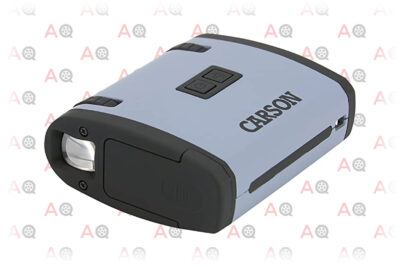
Editor’s Rating:
Facts at a Glance
- Type: Digital
- Magnification: 1x
- Illuminator: Included
- Demo Video
What’s It Best For?
The one thing that makes the Carson MiniAura stand out is its size. This thing is tiny. It weighs less than anything else on our list, and it can easily fit into your pocket. When you combine that with the low price, you get a perfect piece of equipment to store in your emergency kit.
The image quality isn’t very good, but it works well enough to let you find your way around when there’s no light. When the conditions get bad, being able to find your way around is paramount. Just be sure to keep some AAAs in the kit alongside it.
How Does It Compare?
There is no comparison when it comes to size and cost, so if those are your biggest concerns, this is the one to get. It’s also straightforward to use, but that’s because it’s so simple. Everything else on the list has better image quality, though, and most have better build quality as well.
The easiest comparison to make is to the similarly inexpensive Firefield Nightfall. Unfortunately, the Carson MiniAura looks really weak by comparison. The Nightfall has some magnification, doesn’t require as much power, and has much better image quality. If you plan on using the monocular often or don’t mind spending a few more dollars for a better image, the Nightfall is a much better value.
The Nightfall won’t fit in your shirt pocket, though. You’ll have to decide if the ultra-compact size is worth sacrificing some visibility.
Pros
- Inexpensive
- Very small and easy to transport
- Easy to use
Cons
- Image quality could be better
- It’s not as durable as competitors
10. Best Monocular Alternative: WP7 Rugged Smartphone

Editor’s Rating:
Facts at a Glance
- Type: Digital
- Magnification: 1x
- Illuminator: Included
- Demo Video
What’s It Best For?
There are people that spend a lot of time outdoors at night. Adventurers, hunters, campers, and all manner of handy people often find themselves having to perform tasks and move around after dark, so it makes sense for them to own some manner of night vision device. Almost all people nowadays have a cellphone as well, so it makes sense to combine the two.
Enter the WP7, a smartphone that has a night vision camera on it. There are two scenarios where it really makes sense.
First, it makes a great complementary tool to other devices. You can use it to secure your night vision scope before heading out, for instance. The second thing is that you’ll probably always have it on you. That means if you ever find yourself in a situation where you need to see in the dark, and you didn’t prepare for it, you’ll be able to just pull out your cell phone and use it to find your way out.
How Does It Compare?
It’s a little hard to compare to other devices since nothing else does what it can do. What you will end up seeing is that it’s not an amazing cell phone, and it’s not an amazing night vision device.
Any flagship Android device will put the performance to shame, even if it won’t be as durable. Any dedicated monocular like the Bushnell Equinox will give you better clarity in low light situations, but they can’t do anywhere near as much as a cellphone can do.
This can do both, though, and that’s really amazing. People who want to be prepared for absolutely anything can pick one up and add night vision to their capabilities without needing a separate device.
Pros
- Combines the usefulness of night vision with the convenience of a cell phone
- Android platform is popular and well documented
- It’s very durable
Cons
- It’s not a great cellphone
- It’s not a great night vision device
In-Depth Guide to Night Vision Monoculars
We discussed a lot of things in the short buying guide before the reviews, but there were probably still a handful of things within the reviews that you have questions about. In this section, we’ll go over many of them. To start off with, we’ll say some more about the technology used to help you see in the dark.
How Night Vision Works
As we mentioned before, night vision devices at their core simply take the light that is already out there and magnify it until it’s visible to the human eye.
It is, of course, much more complicated to accomplish that than it is to describe it. If you want to take a dive down that rabbit hole, start with this simple guide. Once you feel a little bit comfortable with the terms, the Department of Homeland Security has a 24-page publication that does an excellent job breaking down different devices across the entire night vision spectrum.
For our purposes, though, let’s stick to looking at the differences between two main technologies.
Traditional (Also Known As Generational)
Traditional devices have a lens that lets in light, and you look through that lens. There is a device behind the lens that amplifies light. The differences between generations largely come down to how the amplifier is constructed.
There are 4 generations of traditional night vision technology, with each generation surpassing the previous in quality and range. Usually, consumer devices will be either generation 1 or 2, while military and police hardware will be generation 3 or 4. Price is the most significant barrier between generations. Even generation 3 technology can be over ten times as expensive as generation 1.
If you want to know more about the generations, here is a good article that breaks them down.
Downsides to Traditional Devices
One of the biggest downsides of a traditional device is that it can be damaged by normal light levels. The infrared sensors and amplifiers only last for a set amount of time before the reactive parts are damaged to the point that they no longer function. The more intense light they receive, the faster they degrade. The high price for good quality, that degradation over time, and the technology’s inaccessibility caused digital devices to begin replacing traditional devices, though some budget traditional monoculars still offer good value.
Digital
Digital devices work like a camera. If you take your cell phone, switch it to video mode, and look through the screen, it is working exactly like a digital monocular. In fact, we even have a cell phone on our list that doubles as a night vision camera.
There are a handful of advantages to that. The first is that as technology advances, it becomes cheaper. You can get a very high-quality camera for a fraction of the price of a high-quality traditional night vision device.
Since they do function like a camera and a screen, they can also often transmit live video or offer a variety of visual effects that you can apply directly to the image. Unlike traditional night vision, digital devices can display a wide range of color pallets and even artificially highlight things.
Digital devices also don’t degrade over time, and they can’t be damaged by bright lights. That has led to an increase in the number of devices that work during the day and night. That’s really handy if you are cutting down on the number of things you want to carry around.
Downsides to Digital Devices
There are a few downsides, though. They take a lot more energy, for one thing. You’ll notice that a lot of devices either use a ton of batteries or come with their own lithium battery packs.
They can also be slower to display things that are in view. There is a slight delay between what the lens sees and what gets displayed because the device has to process the image and then refresh the screen. 99% of users won’t have an issue since we are talking about fractions of a fraction of a second here.
When you stack that potential to miss movement with digital’s other big downside, you’ll begin to see why high-end night vision devices still rely on generational technology. Gen 3, 4, and variant night vision devices have no cap on the resolution, other than your eyes. Since it relies on pixels displayed on a tiny screen, a digital device will always have a resolution cap that is not as high as what the average eye can see.
Thermal Imaging

You will notice in our reviews that there are really three separate types of devices. There are traditional devices and digital devices, and then the digital devices are further broken down into ones with thermal imaging and ones without.
In order to refrain from diving into a college-level thesis on the wavelength spectrum, it’s enough to know that both thermal sensors and night vision lenses see in infrared radiation. The IR that night vision sees is much closer to the normal light that we can see, which is why they work well with an IR illuminator. A traditional night vision device amplifies the light we see and the near-infrared light (NIR) and creates a composite image for you to view.
Thermal sensors see the type of infrared that is further away from the visible spectrum. We interpret this as heat, but in reality, it’s only a measurement of the intensity of that infrared radiation. FLIR, one of the most well-known names in thermal imaging, has a good write up about it here.
Traditional vs. Thermal
The big benefit to thermal imaging is that it gives you a ton of contrast since it isn’t affected by visible light. That’s why when you look at a bear in thermal imaging, it’s a big red scary blob against a dark blue background: the bear is warm, the background is cold, and that’s all the sensor “sees.” It doesn’t matter if there are tree branches in the way; they are the same “color” as the background.
The downside is that you lose almost all definition. Since the sensor won’t differentiate between a cold concrete slab and a cold lake, you don’t want to use them for navigation or anything like that. Fortunately, most competent thermal imaging monoculars use a combination of both technologies. That way, you can see Bigfoot and the river you’re about to fall into if you chase him.
Enjoy the Dark
Being able to see in low light situations can help you feel comfortable when light is scarce. That comfort can be from the security you feel when you know what’s out there, or simply feeling safe knowing that you won’t fall down a pit when you are stumbling back to camp. By picking up one of the monoculars we listed, you can have that comfort. Just be sure to let us know if you really do capture that photo of an alien; we’d love to see it.


